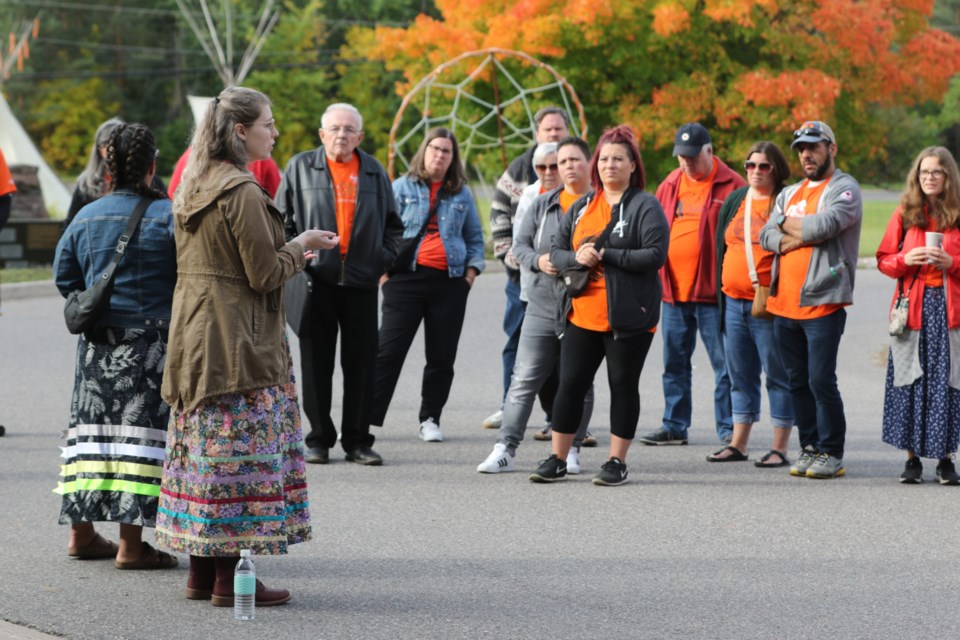EDITOR'S NOTE: Some information in this article has been removed at the request of Shingwauk residential school survivors due to its disturbing nature.
Trigger warning: This article may be upsetting to some readers. A national residential school crisis line has been established to provide support to former students and their families. The 24-hour line can be accessed at 1-866-925-4419.
The Hope for Wellness Helpline is also available to offer immediate support and crisis intervention for Indigenous Peoples across Canada. Call the toll-free Helpline at 1-855-242-3310 or connect to the online chat at www.hopeforwellness.ca.
Algoma University opened its campus to the public Friday to recognize the National Day for Truth and Reconciliation, a day that’s been set aside each year to honour residential school survivors, their families and those who never made it home from those institutions, which were explicitly designed to strip Indigenous Peoples of their culture and language.
The grounds of the university were once home to Shingwauk Indian Residential School, which was funded by the federal government for most of its existence and operated by the Anglican Church in Sault Ste. Marie from 1875 until its closure in 1970. Many remnants of the Shingwauk site still stand on the university campus to this day.
Children of Shingwauk Alumni Association President Jay Jones took part in Friday morning’s guided tour of the former residential school site — the same place where his parents and four of their siblings were all taken to as children. His uncle, Leo Kicknosway, is one of the 72 confirmed Shingwauk students who were buried in the Shingwauk Cemetery, which is located just behind the main building of the university.
“Just to have this day set aside where we can recognize the residential schools, recognize the survivors from those schools and keep that story going forward, that’s the main reason I do this — so the story does not leave us, because our survivors are leaving us,” Jones told SooToday. “I want to make sure this story stays active so more people can learn.”
Jones’ mother, Susie Kicknosway Jones — one of the founding members of the Children of Shingwauk — died in 2019. “My connection is very, very deep here,” said Jones. “My mom always called this home, so when I come up here, I have this comfort.
“Even though this was a residential school and there were atrocities that were committed here, she still called it home. So when I come here, I feel that comfort.”
During a guided tour or ‘truth walk’ of the former residential school grounds, Shingwauk Residential Schools Centre Community Engagement Specialist Chelsie Parayko told participants that many people in the Sault had no idea that Shingwauk had its own graveyard prior to taking a tour of the site.
“The truth is, we also have babies that are buried here, and no one really knows about them,” Parayko told the group of site visitors. “I bring so many people through on truth walks all the time from the city of Sault Ste. Marie, and you would be shocked and appalled at how many people didn’t even know that this was a residential school, let alone the fact that there’s a cemetery in the back of this university,”
Shingwauk Residential Schools Centre and the Children of Shingwauk have confirmed the names of 109 Shingwauk students and staff members who are buried in Shingwauk Cemetery.
But that may not be the true number of people who were buried at the former residential school site.
The Children of Shingwauk Alumni Association is still trying to find out if there were any unmarked burials on the present-day campus of Algoma University. A search for unmarked burials using ground–penetrating radar began in 2021, but it has since been put on hold while the survivors group reaches out to the 85 communities across Canada that saw children taken away to be placed in the Shingwauk school.
It’s hoped the forthcoming community consultations will help uncover some clues that could potentially assist Children of Shingwauk in its search for unmarked burials in Sault Ste. Marie.
“It sounds bad, but those are the type of stories that we need to connect all the dots, to give these stories to the families that need these stories for their closure, because you could be talking two generations ago where they still don’t know where their uncle is, or their grandma or grandpa,” Jones said.
The Children of Shingwauk president anticipates the site search will be a long, drawn-out and complicated process.
“It has to be vetted properly, it has to be analyzed properly. We want to make sure we go to the fullest extent to find out everything we’ve collected,” said Jones. “I want people to know the process is long and arduous, because what you’re dealing with is very sensitive, and you really need to make sure you exhaust all your resources before you present it.”
